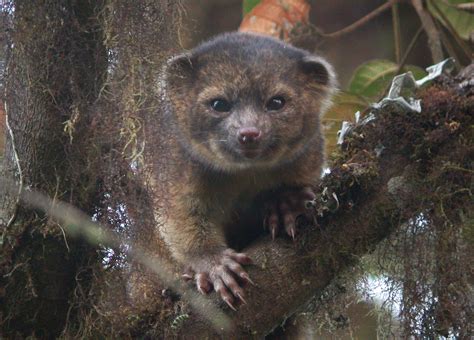
Meet the Olinguito, one of the most enchanting—and the most recently discovered—members of the raccoon family:
With its teddy bear face, fluffy tail, and secretive lifestyle, the Olinguito (Bassaricyon neblina) seems almost too cute to be real. And for most of human history, we didn’t even know it was.
Discovered and described as a new species only in 2013, the olinguito is a small, tree-dwelling mammal that lives in the misty cloud forests of the Andes. Despite belonging to the raccoon family (Procyonidae), it spent decades hiding in plain sight.
Let’s get to know this charming little creature and the story behind its surprising discovery.
What Is an Olinguito?
The Olinguito is a nocturnal, arboreal mammal and the smallest member of the raccoon family. It’s closely related to the olingo, but smaller, furrier, and found at higher elevations. Unlike its urban cousin the raccoon, the olinguito lives quietly among the treetops of Ecuador and Colombia.
Olinguito Fast Facts:
- Scientific name: Bassaricyon neblina
- Size: About 14 inches long (plus a 13–17 inch tail)
- Weight: Around 2 pounds
- Diet: Primarily frugivorous (fruit eater)
- Habitat: Cloud forests of the northern Andes (5,000–9,000 feet elevation)
- Behavior: Solitary, nocturnal, and elusive
A Surprise Discovery
Although specimens of olinguitos had been stored in museums for over a century, scientists had long confused them with similar-looking olingos. It wasn’t until 2013 that Smithsonian zoologist Kristofer Helgen and his team formally described it as a new species—making it the first new carnivorous mammal discovered in the Western Hemisphere in over 30 years.
DNA analysis, skull structure, and fur patterns helped confirm it: the olinguito was a distinct species hiding in plain sight.
How Is It Different from an Olingo?
- Smaller and fluffier
- Shorter face and rounder ears
- Lives at higher elevations
- Thicker fur for the cooler mountain climate
- Less studied and even more elusive
Unlike the louder, more active olingos, olinguitos are quiet and shy, preferring a solitary life high in the canopy.
What Do Olinguitos Eat?
Like their cousins, olinguitos are frugivores, feeding mostly on:
- Wild figs
- Berries
- Nectar
- Occasionally insects or small vertebrates
Their fruit-rich diet makes them important seed dispersers, helping maintain the health of cloud forest ecosystems.
Life in the Cloud Forest
The olinguito’s home—cloud forests—are cool, misty mountain habitats filled with moss-covered trees, orchids, and incredible biodiversity. These forests are isolated, making them perfect for evolution to quietly work its magic over millennia.
But they’re also fragile. Deforestation, agriculture, and climate change pose growing threats to these delicate ecosystems—and to species like the olinguito that depend on them.
Conservation Concerns
Olinguitos are not yet officially listed as endangered, but they face serious risks due to:
- Habitat fragmentation
- Climate shifts affecting cloud forest elevation zones
- Limited range and specialized habitat needs
The more we learn about them, the better we can protect their unique home.
Final Thoughts
The olinguito is a reminder that even in the 21st century, nature still holds secrets. This shy, wide-eyed creature spent centuries hidden in museum drawers and jungle canopies, waiting for someone to look closely enough.
It’s a symbol of how much more we have to discover—and how much we stand to lose if we don’t protect the wild places that hold Earth’s most extraordinary biodiversity.
Want more raccoon relatives? Check out our profiles on the olingo, kinkajou, coati, and more in our “Meet the Raccoon Family” series!
More photos below ↓





Disclaimer: This blog post is for edutainment purposes only and may not be entirely accurate.






